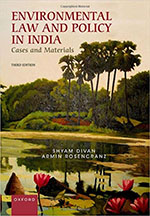Rosencranz’s Environmental Law featured prominently in our lives as law students back in the 1990s. Back then it was the only treatise of any consequence available on Indian environmental law. So, whatever we studied in the subject carried copious references to the work. Encountering its latest incarnation, for good measure nearly twice the size of its first edition, inevitably evokes a sense of nostalgia: in turn this tends to provoke comparisons between the present and previous editions. To be honest, though, nostalgia is not the only reason luring me into comparisons. Environmental law in India has had an uneven growth, and the corresponding evolution of this book functions as a palimpsest recording and then erasing discursive developments in the area.
For instance, the 2001 edition of the work exuded a palpable optimism. It pointed out that till about the 1980s, ‘there was little to distinguish the field of environmental law from the general body of law’. It states that ‘numerous other Indian statutes’ and ‘the body of case law, too, was unremarkable’. It speculates that the devastating Bhopal gas leak of 1984 contributed to the ‘spate of fresh legislation’ on the subject, legislation ‘impressive in their range’. New enforcement agencies were created, old ones were strengthened, ‘enormous administrative power’ was vested in them, innovative regulatory techniques were formulated, and so forth (pp. 1-2). The ‘slack performance’ of enforcement agencies caused courts to intervene significantly through public interest litigation (pp. 3-4). The present edition focuses mainly on the development of environmental law since 2002. Perhaps this is the reason its optimism appears conspicuously diminished. It summarizes India’s environmental law discourse as a ‘regulatory stew of ample legislation, patchy enforcement and ad hoc judicial decisions’ (p. 2); even suggests that the courts’ earlier zeal ‘may be dissipating’ and that ‘The unwritten premise of judicial balancing dressed up as “sustainable development” is that economic growth must continue unimpeded’ (p. 4).

